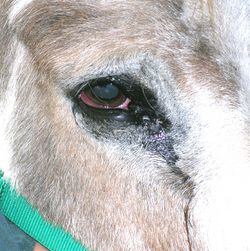Conjunctivitis - Donkey
Jump to navigation
Jump to search
Introduction

Factors involved in the development of conjunctivitis are dust and flies, causing high incidence during the summer months. Stabled environments high in dust, dirt and allergens cause conjunctivitis during the winter. The problem can, therefore, be seen all year round.
Clinical Signs
- Bacterial conjunctivitis is usually secondary. Underlying causes should be sought
- Viral respiratory disease often presents with conjunctivitis. Herpes virus is usually associated with serous discharge. This may be infectious within a group
- Cases showing mucopurulent ocular discharge will invariably have inflamed or injected conjunctiva
Diagnosis
- Ideally swabs should be taken on first examination to obtain bacterial culture and sensitivity, plus viral isolation
- In most cases, removing the cause and applying broadbroad-spectrum topical antibiotics will give an immediate response, which is the practical approach. However, response to treatment must be monitored, and unless swabs were taken at the initial examination, drops must be stopped for two days before sampling to gain information on antibiotic sensitivity
- Fluorescein staining should be used to determine whether there is concurrent ulceration. Watch for the appearance of the stain at the nares within five to ten minutes to check the tear ducts
- Thelazia exists in Europe and North America. These thin, white worms are 1-2 cm long, and damage caused by migration within the eyelids results in conjunctivitis. Heavy infestation may cause clouding and ulceration of the cornea
Treatment
- Try to find and treat the underlying cause, e.g. entropion, viral keratitis, blocked tear ducts
- Apply basic cleansing with moist swabs to keep the eyes clean
- If the discharge is serous, not mucopurulent, then pain or irritation may be the likely cause and topical antibiotics are not indicated. Try not to use antibiotics unless indicated
- If antibiotics are used, then ensure they are applied correctly and the course is completed. Preferably use a culture to decide specificity
- Thelazia usually resolves after about eight weeks. However, topical ivermectin will kill the adult worms
Literature Search
Use these links to find recent scientific publications via CAB Abstracts (log in required unless accessing from a subscribing organisation).
Conjunctivitis in donkeys related publications
References
- Grove, V. (2008) Conditions of the eye In Svendsen, E.D., Duncan, J. and Hadrill, D. (2008) The Professional Handbook of the Donkey, 4th edition, Whittet Books, Chapter 11
|
|
This section was sponsored and content provided by THE DONKEY SANCTUARY |
|---|
